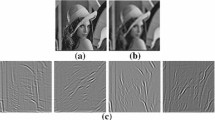Abstract
Currently, the multimode remote sensing (MRS) images are always enhanced with low efficiency, poor effectiveness, and long processing time. Therefore, a self-adaptive enhancement method for MRS images based on Light Detection and Ranging (LiDAR) technology is proposed. Firstly, the problem of LiDAR imaging is replaced by the problem of quadrature-based reconstruction signal based on compression-aware theory. Next, color variance is used as a distance measure of the obtained MRS image by combining the nearest neighbor region map with the adjacent graph segmentation, and the segmented MRS image is decomposed into texture connection regions. Then, coefficients in texture region and connection area are modeled based on decomposition mode. Noise reduction of texture region and connection area is completed by using an adaptive threshold method. Finally, the improved fuzzy contrast operator is used to enhance edge and texture of the image. Experimental results show that the improved method has higher enhancement resolution and larger overall information entropy, which has better enhancement effect on MRS images.




Similar content being viewed by others
References
Abbas K, Farshid FA, Hamid E (2020) Developing an interpretation system for high-resolution remotely sensed images based on hybrid decision-making process in a multi-scale manner. Journal of the Indian Society of Remote Sensing 48(2):197–214
Cresson R (2018) A framework for remote sensing images processing using deep learning technique. IEEE Geosci Remote Sens Lett 5(12):1–5
Cheng G, Yang C, Yao X, Guo L, Han J (2018) When deep learning meets metric learning: remote sensing image scene classification via learning discriminative CNNs. IEEE Trans Geosci Remote Sens 56(5):2811–2821
Liu S, Wang S, Liu X, et al (2020) Fuzzy Detection aided Real-time and Robust Visual Tracking under Complex Environments. IEEE Transactions on Fuzzy Systems: https://doi.org/10.1109/TFUZZ.2020.3006520
Madheswari K, Venkateswaran N (2019) An optimal weighted averaging fusion strategy for remotely sensed images. Multidim Syst Sign Process 30(4):1911–1935
Mohammad K, Farahnaz M (2019) A joint adaptive evolutionary model towards optical image contrast enhancement and geometrical reconstruction approach in underwater remote sensing. SN Applied Sciences 1(10):1–12
Yuan Q, Zhang Q, Li J et al (2018) Hyperspectral image denoising employing a spatial–spectral deep residual convolutional neural network. IEEE Trans Geosci Remote Sens 57(2):1205–1218
Troya-Galvis A, Gancarski P, Berti-Equille L (2018) Remote sensing image analysis by aggregation of segmentation-classification collaborative agents. Pattern Recogn 73(42):259–274
Sowmya DR, Shenoy PD, Venugopal KR (2017) Remote sensing satellite image processing techniques for image classification: a comprehensive survey. International Journal of Computer Applications 161(11):24–37
Kinzel PJ, Legleiter CJ (2019) sUAS-based remote sensing of river discharge using thermal particle image Velocimetry and bathymetric LiDAR. Remote Sens 11(19):2317
Biasutti P, Aujol JF, Brédif M, Bugeau A (2018) Range-image: incorporating sensor topology for LiDAR point cloud processing. Photogramm Eng Remote Sens 84(6):367–375
Perrone MR, Romano S (2018) Relationship between the planetary boundary layer height and the particle scattering coefficient at the surface. Atmos Res 213:57–69
Rizeei HM, Pradhan B (2019) Urban mapping accuracy enhancement in high-rise built-up areas deployed by 3D-orthorectification correction from WorldView-3 and LiDAR imageries. Remote Sens 11(6):692
Wang G, Li W, Zuluaga MA, Pratt R, Patel PA, Aertsen M, Doel T, David AL, Deprest J, Ourselin S, Vercauteren T (2018) Interactive medical image segmentation using deep learning with image-specific fine tuning. IEEE Trans Med Imaging 37(7):1562–1573
Burigana L, Magnini L (2017) Image processing and analysis of radar and LiDAR data: new discoveries in Verona southern lowland (Italy). STAR: Science & Technology of Archaeological Research 3(2):490–509
Liu S, Guo C, Al-Turjman F et al (2020) Reliability of response region: a novel mechanism in visual tracking by edge computing for IIoT environments. Mech Syst Signal Process 138:106537
Ma J, Jiang J, Zhou H, Zhao J, Guo X (2018) Guided locality preserving feature matching for remote sensing image registration. IEEE Trans Geosci Remote Sens 56(8):4435–4447
Cao R, Zhang Y, Liu X, Zhao Z (2017) Roof plane extraction from airborne LiDAR point clouds. Int J Remote Sens 38(12):3684–3703
Wei L, Yang B, Jiang J, Cao G, Wu M (2017) Vegetation filtering algorithm for UAV-borne LiDAR point clouds: a case study in the middle-lower Yangtze River riparian zone. Int J Remote Sens 38(8–10):2991–3002
Zheng P, Shuai L, Arun S et al (2018) Visual attention feature (VAF): a novel strategy for visual tracking based on cloud platform in intelligent surveillance systems. Journal of Parallel and Distributed Computing 120:182–194
Hakkenberg CR, Peet RK, Urban DL et al (2018) Modeling plant composition as community continua in a forest landscape with L i DAR and hyperspectral remote sensing. Ecological Applications 28(1):177–190
Kellner JR, Armston J, Birrer M, Cushman KC, Duncanson L, Eck C, Falleger C, Imbach B, Král K, Krůček M, Trochta J, Vrška T, Zgraggen C (2019) New opportunities for forest remote sensing through ultra-high-density drone LiDAR. Surv Geophys 40(4):959–977
Thiel C, Schmullius C (2017) Comparison of UAV photograph-based and airborne LiDAR-based point clouds over forest from a forestry application perspective. Int J Remote Sens 38(8–10):2411–2426
Li D, Zhang R (2018) Ensemble stacked auto-encoder classification on LiDAR remote sensing images. Journal of the Indian Society of Remote Sensing 46(4):597–604
Zhang J, Lin X (2017) Advances in fusion of optical imagery and LiDAR point cloud applied to photogrammetry and remote sensing. Int J Image Data Fusion 8(1):1–31
Cheng G, Han J, Lu X (2017) Remote sensing image scene classification: benchmark and state of the art. Proc IEEE 105(10):1865–1883
Falez P, Tirilly P, Bilasco IM et al (2019) Unsupervised visual feature learning with spike-timing-dependent plasticity: how far are we from traditional feature learning approaches. Pattern Recogn 93(6):17–26
VishnuVG (2019) High performance multiple sclerosis classification by data augmentation and AlexNet transfer learning model. Journal of Medical Imaging and Health Informatics 9(9):2012–2021
Author information
Authors and Affiliations
Corresponding author
Additional information
Publisher’s note
Springer Nature remains neutral with regard to jurisdictional claims in published maps and institutional affiliations.
Rights and permissions
About this article
Cite this article
Zhang, X., Muhammad, K. Adaptive Enhancement Method for Multimode Remote Sensing Image Based on LiDAR. Mobile Netw Appl 25, 2390–2397 (2020). https://doi.org/10.1007/s11036-020-01616-1
Published:
Issue Date:
DOI: https://doi.org/10.1007/s11036-020-01616-1




